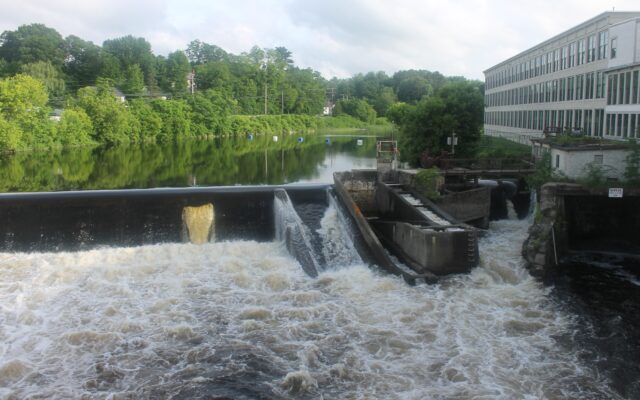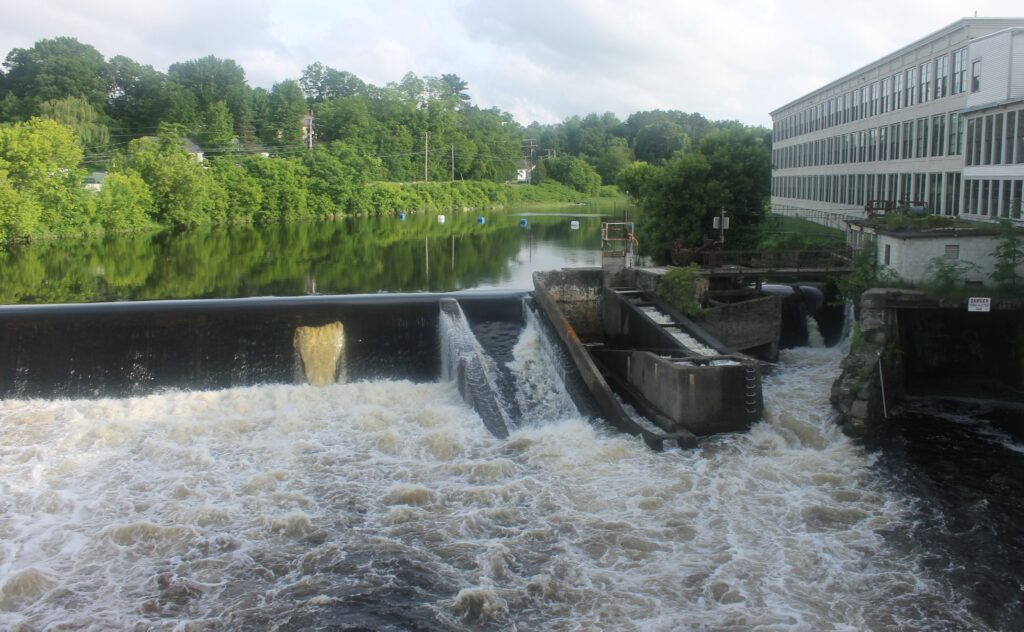
Feasibility study will help determine Mayo Mill Dam future
DOVER-FOXCROFT — More than a decade and a half has passed since the Mayo Mill Dam on the Piscataquis River in downtown Dover-Foxcroft has produced energy. In the years since the municipal-owned structure has remained in place but it is only deteriorating under the continual water flow.
There are no easy answers on what to do with the site but under the auspices of a steering committee, a partners team is working to consider the various possibilities and everything tying into the dam — such as an assessment of the physical condition of the structure and property, an inventory, and being in compliance with all regulations — to be included in a community-based feasibility study to help determine the long-term future of the Mayo Mill Dam. The public was invited to learn more during a June 27 forum at the Central Hall Commons.
Per the project website, the feasibility and alternatives analysis report will provide a series of options for the town to consider for the dam and powerhouse. For each alternative option, the report will summarize factors including timely and effective fish passage, upfront and life costs, constructability, operation and maintenance requirements, compliance with state and federal regulations, public safety and liability, and enhancement of public amenities in the historic Dover-Foxcroft Downtown and Mill District Corridor and Gateway.

MAYO MILL DAM — The Mayo Mill Dam on the Piscataquis River in downtown Dover-Foxcroft. A team of organizations and a steering committee is working on a feasibility study to help determine the long-term future of the structure.
The agreement between the town and team only commits both entities to completing the feasibility study through to the selection of a final project design and the final report. Support for future phases of work is contingent upon the outcome of this process and will be determined in the future.
Town Manager Jack Clukey began the evening with a brief overview of the dam history, saying the first was built in 1920 with concrete and the current dam was constructed in 1980. The dam is 12 feet high and 150 feet in length with a 30-acre impoundment.
He said in 1982 the Federal Energy Regulatory Commission gave a license exemption which is still in place.
Atlantic salmon were listed under the Endangered Species Act in 2000 and the fish travel up and down the Piscataquis River. Clukey said the river was deemed to be critical habitat in 2009.
“In 2007 we know Moosehead Manufacturing closed and that’s when the energy production stopped,” Clukey said. He said the mill property was conveyed to the Dover-Foxcroft to join the municipal dam ownership, and since then the building has been redeveloped into a multi-use facility with apartments, boutique hotel, cafe, and office space. The hope was to restore hydropower production to provide electricity to adjacent properties.
Clukey said from 2010-21 there was “a long thorough process to find a way to restart the feasibility.” The town has consulted with multiple engineers, turbine suppliers, and a private developer for years to try to identify a hydropower retrofit and determined that there are no economically viable options.
He said last year the town issued a request for proposals to explore new options for the site that will allow it to meet state and federal regulations. The only proposal submitted was from the Atlantic Salmon Federation and partners, The Nature Conservancy in Maine and Inter-Fluve, Inc.
In October the select board signed a partnership agreement with ASF to produce a study report that will evaluate feasible concept options for the town to consider. Funding for the report is provided by National Oceanic and Atmospheric Administration Fisheries through the Infrastructure and Investment Jobs Act and there is no cost to Dover-Foxcroft.
Clukey said in December the town submitted an amendment to FERC for withdrawal and revalution. A 5-member steering committee was convened this year and the group meets monthly to oversee the partnership and will make a recommendation on a preferred alternative to the select board in November.
A slide said a decision on the Mayo Mill Dam needs to be made at the present time due to regulatory requirements on fish passage and funding availability for dam work. Dover-Foxcroft is also working on adjacent downtown projects concerning vehicle movement and pedestrian access for sustainable long-term solutions.
Maranda Nemeth, Atlantic Salmon Federation project manager, said the organization has done a number of fish passage projects across the Penobscot River watershed and has worked with The Nature Conservancy and Inter-Fluve, Inc. — an employee-owned small business that has been on the forefront of river and stream engineering, management, and restoration practice – previously and the missions all will align. She also said salmon habitat is only good if it is accessible upstream and downstream.
Nemeth said a project website is up at https://www.mayomilldamstudy.com which includes all relevant information. “We did not offer a direct solution but we did give the town a detailed process so they can meet their obligations and their commitment to the downtown,” she said.
“We would love to partner together on a solution,” Nemeth said. She explained the feasibility study will have a series of options to be compared with one another.
“The Piscataquis River has deep meaning and history to Dover-Foxcroft,” Nemeth said, saying the town recently celebrated the 100th anniversary of the former two communities coming together. “At the same time the town is facing a bit of a challenge with this facility that is aging every day. Our goal is to go through the community-based project to understand the dam’s condition, capability, and be part of the larger vision for the future.”
Nemeth said just downstream is the privately-owned Browns Mill Dam with a functional fishway and a vertical barrier to keep out invasive northern pike. She was asked about the dam upstream in downtown Guilford. The Nature Conservancy is working with owner Duvaltex on the engineering and design of dam removal and demolition of several low-lying structures.
“If that project were to continue it would have no impact on the dam downstream,” said Eileen Bader Hall, project manager for The Nature Conservancy.
The mainstem Piscataquis River is a critical migratory corridor for native species of sea-run fish, including American shad, American eel, river herring, and Atlantic salmon, according to the organizations. Despite a fishway at the dam, upstream and downstream fish passage remains an impediment to various species of fish, which reduces the number that can use the spawning habitat found upstream.
The public forum featured a number of questions from the dozens in the audience.
Inter-Fluve, Inc. Professional Engineer Mike Burke was asked about the hydropower capabilities. He said the two generating units can produce up to 300 kilowatts and the license is still valid. “It’s almost in a suspended condition because it hasn’t generated power in 15 years,” he said.
A comment expressed concern over what the dam site may look like. Nemeth said the study will have three to five different options with graphic renderings at the conceptual level.
“There’s no assumption that the dam is being removed,” Select Board Chairperson/steering committee member Cindy Freeman Cyr said. She said she wants to remove the fear of this that the structure would be taken out under all possibilities to be presented.
Freeman Cyr what is more likely is a different looking but more efficient fish passage would be constructed.
Selectperson Tom Lizotte of the steering committee said that no one really knows what the natural state of the Piscataquis River through town looks like as a dam has been in place for more than a century and the area has been developed with a mill for around two centuries.
Burke was asked about the performance of the dam fishway. He said it was built to operate with hydropower, but now there are “multiple streams” instead of one ideal passage for fish to go through and this does not meet guidelines. Burke said there has been no study on numbers in nearly two decades.
A question about the barriers to restarting hydropower was posed, and Clukey said there are no economic incentives for a private company to come in and make the necessary improvements for this. The town worked with several firms to assess the costs and potential for generating electricity again, but no viable option emerged.
An audience member wondered if the dam is removed, will there still need to be a fishway?
“That’s a great question, that’s something we will be looking at with this study,” Burke responded, as the answer varies depending on the body of water.
“Flooding is a huge layer to this work,” Nemeth said, adding water pollution data will also be analyzed. Burke added that the study will utilize computer modeling to examine the impact of flow level changes.
Nemeth concluded the program by telling attendees how they can stay involved. She said the steering committee meets monthly and the website is updated regularly. “You can expect another public forum in the fall when we have a report to hand out,” she said.